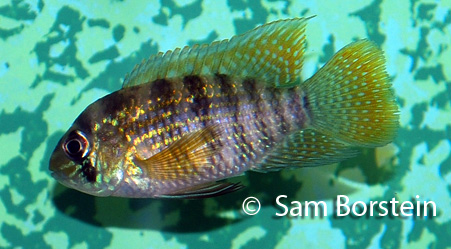Andinoacara sp. "rio inirida"
Synonyms: Aequidens sp. "rio inirida"

Above: Andinoacara sp. "rio inirida". Photo by Sam Borstein.
Etymology:
Genus- Andino= named after the Andes Mountains, acara= traditional name for cichlid fish).
Species- "rio inirida"= Found in the Rio Inirida.
Intro:
Andinoacara sp. "rio inirida" is a new fish to the hobby. Not much is known about this new Blue Acara type, other than it is found in the Rio Inirida, located in Columbia and flows into the Rio Orinoco.
In 2009, Musilova et. al. described a new genus for the Blue Acara and Green Terror like species (Formerly Aequidens) and has named it Andinoacara. Although they do not speak of this species in the paper, it is a Blue Acara type and does belong to this genus.
Distribution:
This fish is located in the Rio Inirida which is located in Columbia and empties into the Orinoco.
Size, Maturity, and Sexual Dimorphism:
Size: Males- 5 inches, Females- 4 inches
Maturity: 2.5 inches
Sexual Dimorphism: Males are larger than females and are more colorful. Males develop longer fin extensions.
Care:
This fish was very undemanding to keep. They do like their weekly water changes, but seemed to be very tolerant of different water values. The fish is fairly non-aggressive. 2 pairs can easily be kept in a 40 breeder with some other fish.
Diet:
Like said, there is not much info on this fish, but they are also easy to feed. Mine ate every flake and pellet I threw at them.
Breeding:
This fish can be difficult to breed, as they take quite a while to settle in. Once started, they will breed like clockwork. The key is making sure they are the dominant fish in the tank. I like adding some very docile cichlids or rainbow fish for this.
Breeding takes place in the typical Blue Acara fashion. The pair gets very dark and then breeds on any hard surface like driftwood or a rock. The eggs are guarded fiercely and in about 3 days hatch. By 7 days they are free swimming. The fry are small, but can eat baby brine shrimp and grow fast. The spawns are typically between 120-300 eggs.
Conclusion:
This fish looks nice, but is hard to find. It really is a hobbyist fish and not one you will see in pet stores.
References:
- Musilová, Z., Rícan, O. & Novák, J. (2009) Phylogeny of the Neotropical cichlid fish tribe Cichlasomatini (Teleostei: Cichlidae) based on morphological and molecular data, with the description of a new genus.
Journal of Zoological Systematics and Evolutionary Research, 47, 234-247.
